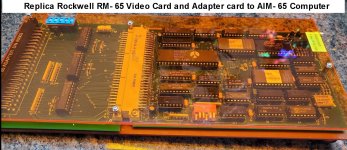There is, but it's all over the place and I'm a very long way from completing it... I've rebuild the video section with just 4 GAL chips ( low-cost programmable logic from the 80s. They were used in the Spectrum 128 ) - and it should be able to run 512x192 graphics in 8/16 colours or 256x192 in 64 colours over four nominal planes, and I've designed the hardware vector graphics drawing support, but haven't worked out whether to operate it whent he video isn't accessing, or while the CPU waits, but with 1985 era chips the video system has an access time of around 220ns at zero wait for read, can get as fast as 70ns and writes can occur at any speed since they are buffered but require a cooldown of 140ns before the next write, which is amazingly fast for low-cost chips of the era. I've only tested the video with an 8052 microcontroller so far, but it works as expected. It works on a different principle that if the video ram is twice the speed that the video architecture requires, then it can be bus multiplexed without multiplexing ICs reducing around 60% of the circuitry required, and the CPU interface can asynchronously at 1/3 of of the RAM speed without contention... That was kind of where the Loki appeared to be going. And I can't get ULAs so I'm using GALs as a reasonable alternative for the era.
Basing it on Sir Clive's original claimed specifications, there are ways to cheat with things like video timing but I've assembled an architecture for a megabyte of addressable memory with separate process IDs for each program running ( it does support multitasking but the current OS is purely aimed at CP/M 2.2 ) - Speaking of which, once I built the emulator, I started writing the LokiOS, since that was the biggest task, and one I could do in my spare time, so I wrote a CP/M compatible OS that is so close to CP/M 2.2 that it's possible to switch the BDOS or CCP with the real one, and it keeps on running without too many issues, though ending programs still causes some trouble and I need to bugfix that. The memory itself is managed by raw CP/M BDOS calls repurposed as a MMU, which works remarkably well, so the full megabyte is a RAM drive, and it's possible to log to M: and not only use it as a ram drive, but if you do a DIR, you can see the memory map in the files exactly where they are located in memory, so for example, you can load up microsoft basic, open the Video File as read-write and directly read/write the 128k video memory from Basic80 under Normal CP/M and it works... It's an interesting converged architecture. It even uses INDR and OTDR to block transfer memory between I/O and the memory space either directly or under BDOS... And programs can just open themselves as a file as an alternative to needing to be aware of the extra paging hardware.
But most important was the price goal of under 200 GBP or USD400... Which is why the Loki was considered impossible. Loki was always supposed to run CP/M, but that would have made it impossible as license costs would have killed it, so it needed a custom CP/M compatible OS to run it, and specialised drivers for the video system that don't take up space in the TPA, since the video itself is nearly twice the size of most TPAs. I wrote LokiOS last year, and this year I'm working on a native z80 assembler for it, but it will also work under CP/M since the OS is close enough that any CP/M software should work on Loki. Both are available for free on Github.
Next year I hope to finish the hardware design.
Hmm. Kmart diners... With crinkle cut chips and gravy... It really was a treat when my mum went shopping there... That's where I picked up my love of Trifle too. They just made it in the small clear plastic cups that you normally drink from at parties. I was so saddened to see them disappear. KMart needs to put them back... That's what we need to fix the modern era here in Oz... Kmart diners with $5 lunches and $2 coffees.... ( updated prices for the modern era ). For a long time all KMarts were the same and you could find all the same things in any kmart anywhere you went and they were in the same place. No getting lost in the stores... No time wasted... Before they all started price gouging.



